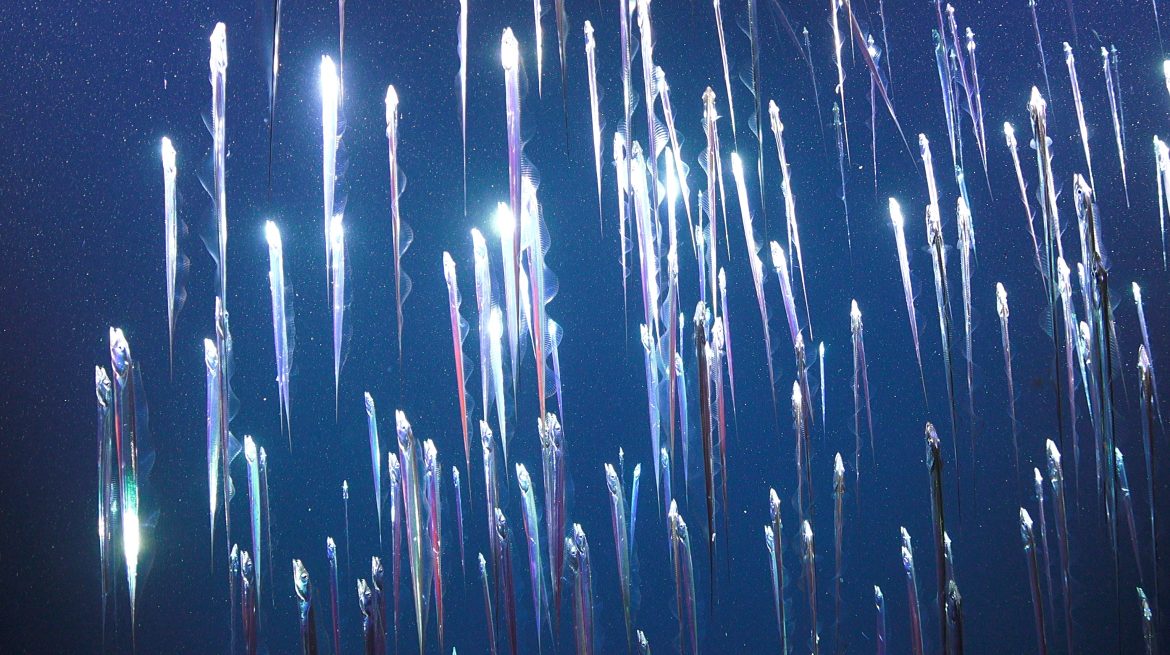Emilija Škarnulytė, Aphotic Zone, 2022

Emilija Škarnulytė, Aphotic Zone, 2022. Video. Duration: 15 mins. Image credits: Emilija Škarnulytė, Aphotic Zone, 2022. Courtesy of the artist, Erik Cordes and the Schmidt Ocean Institute, and Fondazione In Between Art Film
Please note, while Emilija Škarnulytė’s Aphotic Zone is no longer available to watch online, it is still available to see in the Gallery until 5 February 2023.
A cinematic journey across space and time, Emilija Škarnulytė‘s Aphotic Zone peers back from the future through dark oceans to witness the threats of climate crisis and economic extractivism; the idealistic prospects of science; and the catastrophic consequences of human greed.
Luminous sea jellies beam over choirs of fish as we travel 4km deep past the Pacific seamounts off Costa Rica to reach the pitch black ‘aphotic’ zone of the sea. At the bottom, an ROV drawn from documentary footage carefully samples deep sea corals with robotic arms until it passes into the digital imaginary of a sharply risen ocean. There, the Duga radar (a Soviet-era missile defense system near Chernobyl) is an undersea ruin far beneath the waves. Both documentary and oneiric, the film moves through a landscape of prehistoric life and advanced technology.
Mixed by Oscar-winning sound engineers Jaime Baksht and Michelle Couttolenc, the film’s soundtrack is drawn from a field recording made in Mexico City’s Zócalo on the 500th anniversary of Spain’s conquest of Tenochtitlan. Ecological devastation echoes colonial destruction and the street sounds of CDMX become a ghost warning us of the cataclysms yet to come
Emilija Škarnulytė (b. Vilnius, Lithuania 1987) is an artist and filmmaker.
Working between documentary and the imaginary, Škarnulytė makes films and immersive installations exploring deep time and invisible structures, from the cosmic and geologic to the ecological and political. Her blind grandmother gently touches the weathered statue of a Soviet dictator. Neutrino detectors and particle colliders measure the cosmos with otherworldly architecture. Post-human species swim through submarine tunnels above the Arctic Circle and crawl through tectonic fault lines in the Middle Eastern desert.
Winner of the 2019 Future Generation Art Prize, Škarnulytė represented Lithuania at the XXII Triennale di Milano and was included in the Baltic Pavilion at the 2018 Venice Biennale of Architecture. With solo exhibitions at Tate Modern (2021), Kunsthaus Pasquart (2021), Den Frie (2021), National Gallery of Art in Vilnius (2021), CAC (2015) and Kunstlerhaus Bethanien (2017), she has participated in group shows at Ballroom Marfa, Seoul Museum of Art, Kadist Foundation, and the First Riga Biennial. In 2022, Škarnulytė participated in the group exhibition Penumbra organized by Fondazione In Between Art Film on the occasion of the 59th Venice Biennale. Her numerous prizes include the Kino der Kunst Project Award, Munich (2017); Spare Bank Foundation DNB Artist Award (2017), and the National Lithuanian Art Prize for Young Artists (2016). She received an undergraduate degree from the Brera Academy of Art in Milan and holds a masters from the Tromsø Academy of Contemporary Art.
Her films are in the IFA, Kadist Foundation and Centre Pompidou collections and have been screened at the Serpentine Gallery, UK, Centre Pompidou, France, and the Museum of Modern Art, New York and in numerous film festivals including in Rotterdam, Busan, and Oberhausen. She is a founder and currently co-directs Polar Film Lab, a collective for analogue film practice located in Tromsø, Norway and is a member of artist duo New Mineral Collective, recently commissioned for a new work by the First Toronto Biennial.
Her most recent monograph Sirenomelia (2021) is currently available from Sternberg Press.
